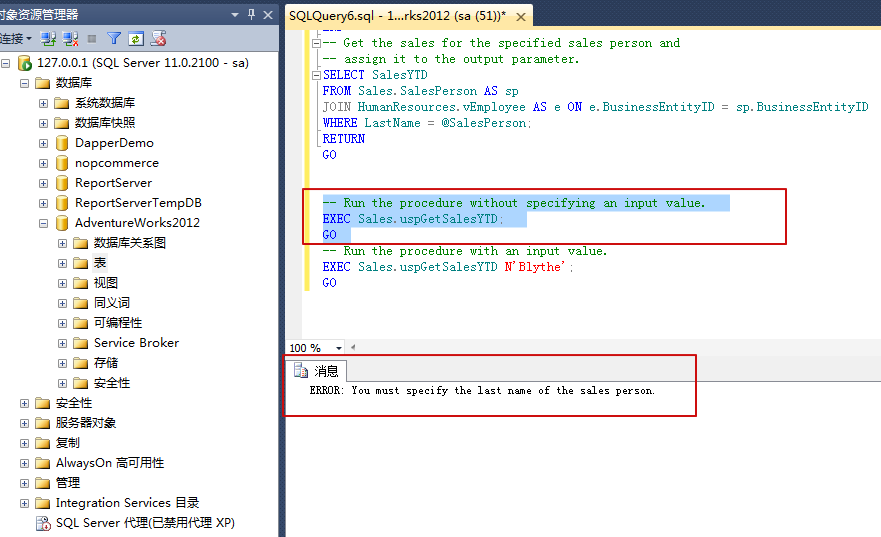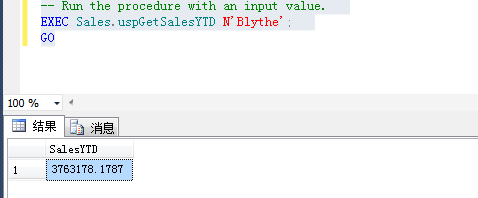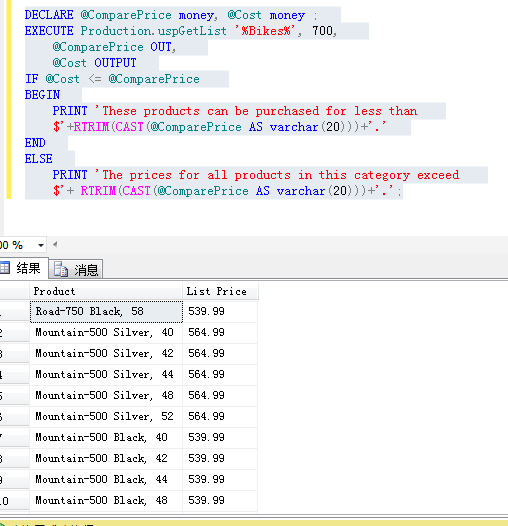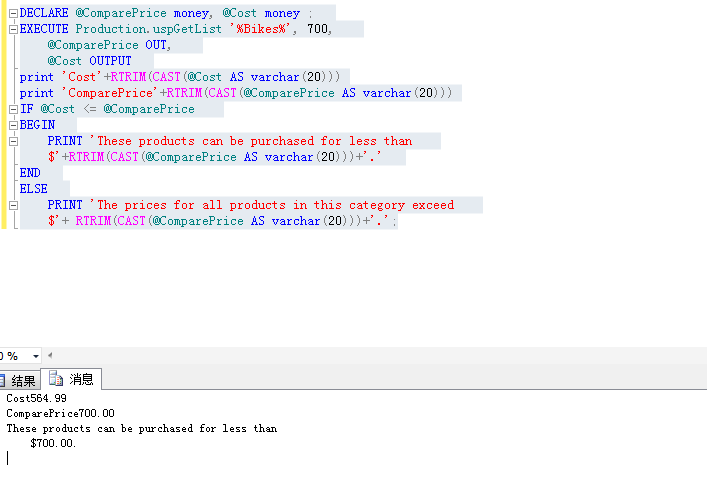通过指定过程参数,调用程序可以将值传递给过程的主体。
如果将参数标记为 OUTPUT 参数,则过程参数还可以将值返回给调用程序。
一个过程最多可以有 2100 个参数,每个参数都有名称、数据类型和方向。 还可以为参数指定默认值(可选)。
将值传递给参数
使用过程调用提供的参数值必须为常量或变量,不能将函数名称作为参数值。 变量可以是用户定义的变量或系统变量(如 @@spid)。
下列示例演示如何将参数值传递给过程 uspGetWhereUsedProductID。 它们说明了如何将参数作为常量和变量进行传递,以及如何使用变量传递函数值。
USE AdventureWorks2012; GO -- Passing values as constants. 传递常量 EXEC dbo.uspGetWhereUsedProductID 819, '20050225'; GO -- Passing values as variables. 传递变量 DECLARE @ProductID int, @CheckDate datetime; SET @ProductID = 819; SET @CheckDate = '20050225'; EXEC dbo.uspGetWhereUsedProductID @ProductID, @CheckDate; GO -- Try to use a function as a parameter value. -- This produces an error message. 传递函数,报错 EXEC dbo.uspGetWhereUsedProductID 819, GETDATE(); GO -- Passing the function value as a variable. DECLARE @CheckDate datetime; SET @CheckDate = GETDATE(); EXEC dbo.uspGetWhereUsedProductID 819, @CheckDate; GO
在存储过程中定义参数
1.需要指定参数名称
2.指定参数数据类型
3.可以指定参数默认值
4.可以指定参数方式(默认为输入参数)
示例1:
USE AdventureWorks2012; GO IF OBJECT_ID('Sales.uspGetSalesYTD', 'P') IS NOT NULL DROP PROCEDURE Sales.uspGetSalesYTD; GO CREATE PROCEDURE Sales.uspGetSalesYTD @SalesPerson nvarchar(50) = NULL -- NULL default value AS SET NOCOUNT ON; -- Validate the @SalesPerson parameter. IF @SalesPerson IS NULL BEGIN PRINT 'ERROR: You must specify the last name of the sales person.' RETURN END -- Get the sales for the specified sales person and -- assign it to the output parameter. SELECT SalesYTD FROM Sales.SalesPerson AS sp JOIN HumanResources.vEmployee AS e ON e.BusinessEntityID = sp.BusinessEntityID WHERE LastName = @SalesPerson; RETURN GO
运行如下
-- Run the procedure without specifying an input value. EXEC Sales.uspGetSalesYTD; GO -- Run the procedure with an input value. EXEC Sales.uspGetSalesYTD N'Blythe'; GO


示例2:
USE AdventureWorks2012; GO IF OBJECT_ID ( 'Production.uspGetList', 'P' ) IS NOT NULL DROP PROCEDURE Production.uspGetList; GO CREATE PROCEDURE Production.uspGetList @Product varchar(40) , @MaxPrice money , @ComparePrice money OUTPUT , @ListPrice money OUT AS SET NOCOUNT ON; SELECT p.[Name] AS Product, p.ListPrice AS 'List Price' FROM Production.Product AS p JOIN Production.ProductSubcategory AS s ON p.ProductSubcategoryID = s.ProductSubcategoryID WHERE s.[Name] LIKE @Product AND p.ListPrice < @MaxPrice; -- Populate the output variable @ListPprice. SET @ListPrice = (SELECT MAX(p.ListPrice) FROM Production.Product AS p JOIN Production.ProductSubcategory AS s ON p.ProductSubcategoryID = s.ProductSubcategoryID WHERE s.[Name] LIKE @Product AND p.ListPrice < @MaxPrice); -- Populate the output variable @compareprice. SET @ComparePrice = @MaxPrice; GO
运行如下脚本
DECLARE @ComparePrice money, @Cost money ; EXECUTE Production.uspGetList '%Bikes%', 700, @ComparePrice OUT, @Cost OUTPUT print 'Cost'+RTRIM(CAST(@Cost AS varchar(20))) print 'ComparePrice'+RTRIM(CAST(@ComparePrice AS varchar(20))) IF @Cost <= @ComparePrice BEGIN PRINT 'These products can be purchased for less than $'+RTRIM(CAST(@ComparePrice AS varchar(20)))+'.' END ELSE PRINT 'The prices for all products in this category exceed $'+ RTRIM(CAST(@ComparePrice AS varchar(20)))+'.';
效果

